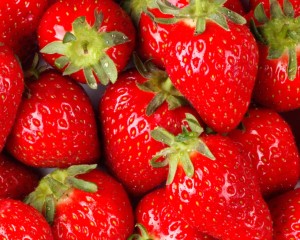I’m in semi-rural Ontario (that’s in Canada) where the Internet isn’t great but the company is. Living in North Carolina is excellent but it is nice to be with family for a week or so a couple of times a year. The kids hangout with the grandparents and aunt, Dani gets some quiet time with a book and I get some golf in with my dad and father in-law.
We played yesterday and on the way home we picked up some berries from a farm stand.
Pop-pop (as my kids call him) snuck a couple of berries and said “I guess I should be washing these first.” I told him that if they were contaminated it probably didn’t matter a whole lot what we did in the kitchen or on the back deck – we aren’t able to remove much more than 90 per cent of the contamination. Not all that protective with bacterial or viral pathogens with a low mean infectious dose. What matters the most is what the farmer did during production and harvest to keep the pathogens off the berries.
I told a similar story to Paige Brown, guest contributor to Forbes last week about the Townsend Farms hepatitis A in frozen berries mix outbreak that has been linked to 118 illnesses and 54 hospitalizations. While this one appears to be linked to pomegranate seeds from Turkey (sort of sounds like last year’s Canadian hepatitis A outbreak in a frozen berry mix), the same principles apply – keep the poop off the stuff before it gets to the grocery store.
“Historically, there are a few foods that are more susceptible to hepatitis A contamination than others,” said Benjamin Chapman, Food Safety Specialist at North Carolina State University in Raleigh. “Berries are a hot potential area.”
When these types of outbreaks do occur, they can often be tied to contaminated water used in food processing, especially for foods such as berries and fruits that are not cooked. 
“To me, I wouldn’t be surprised if irrigation water or water used to cool the berries was responsible for the contamination,” Chapman said. “At least, it is unlikely that water is not involved.”
“Berries are a tough product because washing destroys them, and the virus gets into tiny holes (spaces -ben) inside the berry. To me, it’s about preventing contamination in the first place, because once the virus is on [a food product], it is really hard to get rid of it.”
Lee-Ann Jaykus’ lab uses molecular biological methods for the detection of pathogenic microorganisms in foods, including the hepatitis A virus and norovirus. On top of the complexity of the food system, Jaykus said, virus detection hurdles often make it hard to pin-point a particular food product and contaminated ingredient.
“There are not really good methods to detect hepatitis A in a contaminated food products,” Jaykus said. “I know there are laboratories around the country that are working to detect it in food products. But just because you can’t detect it, doesn’t mean it’s not there.”
“Most of human disease is caused by the 1 genotype,” Jaykus said. “And within this genotype, most disease is caused by the strain 1A. But this particular outbreak is caused by strain 1B. That makes it unique because it is a strain less often associated with human disease relative to 1A.”
The hepatitis virus strain 1B is not typically seen in North and South America, but is more frequently seen in Asia and the Middle East.
Along with the handling practices and water quality at the processing site, FDA and Oregon Dept of Ag need to look at Townsend Farms’ supplier controls, especially with the 1B strain link.
In related news, foodborne disease epidemiologist extraordinare Bill Keene of the Oregon Public Health Division was cited in the Oregonian as saying that public health efforts related to Townsend Farms’ processing facility have focused on whether contaminated product has led to infections within employees who handled potentially contaminated product.
The point of the inspection was to ensure that no employee had become infected by the Organic Antioxidant Blend or, in turn, passed the virus to friends or family.
William Keene, senior epidemiologist at the Public Health Division, said health officials are concerned about secondary cases and people who might have unknowingly consumed the blend, for example at a restaurant.
